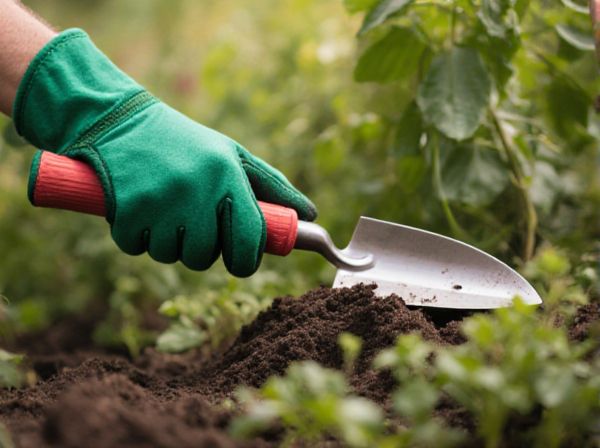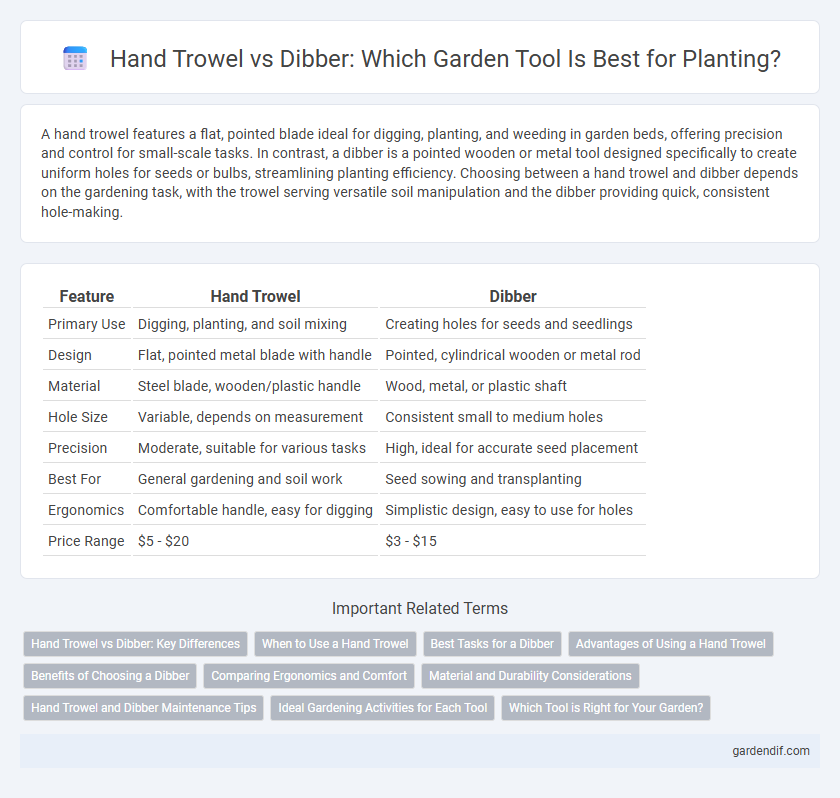
Hand trowel vs dibber Illustration
A hand trowel features a flat, pointed blade ideal for digging, planting, and weeding in garden beds, offering precision and control for small-scale tasks. In contrast, a dibber is a pointed wooden or metal tool designed specifically to create uniform holes for seeds or bulbs, streamlining planting efficiency. Choosing between a hand trowel and dibber depends on the gardening task, with the trowel serving versatile soil manipulation and the dibber providing quick, consistent hole-making.
Table of Comparison
| Feature | Hand Trowel | Dibber |
|---|---|---|
| Primary Use | Digging, planting, and soil mixing | Creating holes for seeds and seedlings |
| Design | Flat, pointed metal blade with handle | Pointed, cylindrical wooden or metal rod |
| Material | Steel blade, wooden/plastic handle | Wood, metal, or plastic shaft |
| Hole Size | Variable, depends on measurement | Consistent small to medium holes |
| Precision | Moderate, suitable for various tasks | High, ideal for accurate seed placement |
| Best For | General gardening and soil work | Seed sowing and transplanting |
| Ergonomics | Comfortable handle, easy for digging | Simplistic design, easy to use for holes |
| Price Range | $5 - $20 | $3 - $15 |
Hand Trowel vs Dibber: Key Differences
Hand trowels feature a flat, curved blade ideal for digging, planting, and soil loosening, while dibbers have pointed, narrow tips designed for creating precise holes for seeds and bulbs. The ergonomic handles of hand trowels provide better leverage and control for broader gardening tasks, whereas dibbers excel in accuracy and depth control for seed planting. Selecting between a hand trowel and a dibber depends on whether your gardening requires versatile digging or specialized hole making.
When to Use a Hand Trowel
A hand trowel is ideal for digging small holes, transplanting seedlings, and mixing soil or fertilizer in garden beds where precision is required. Unlike a dibber, which is primarily used for creating uniform planting holes for seeds or bulbs, the hand trowel offers versatility for a range of gardening tasks including weeding and soil loosening. Use a hand trowel when maneuvering around delicate plants or working in confined spaces that demand more control.
Best Tasks for a Dibber
A dibber excels at creating precise planting holes for seeds, seedlings, and bulbs, making it ideal for tasks like sowing carrots, onions, and tulips. Its pointed, tapered design allows for consistent soil depth and spacing, which promotes uniform germination and growth. Unlike a hand trowel, a dibber is best suited for delicate planting tasks requiring accuracy rather than soil digging or transplanting.
Advantages of Using a Hand Trowel
A hand trowel offers precise soil control and versatility for planting, weeding, and digging small holes compared to a dibber, which is primarily used for making uniform holes. Its flat, curved blade design enables efficient soil scooping and aeration, enhancing plant root development. The ergonomic handle of a hand trowel reduces hand fatigue, making it ideal for extended gardening tasks.
Benefits of Choosing a Dibber
A dibber offers precise, consistent hole depth for planting seeds and bulbs, enhancing germination rates and uniform plant growth. Its tapered design reduces soil disturbance, preserving soil structure and moisture levels vital for seedling development. Choosing a dibber increases efficiency in garden tasks by simplifying the planting process, especially in tight or densely planted spaces.
Comparing Ergonomics and Comfort
Hand trowels offer a contoured handle and balanced weight distribution that reduce strain during prolonged digging or planting tasks. Dibbers feature a straight shaft design that allows for precise hole making but may cause more wrist fatigue due to limited grip options. Ergonomic hand trowels typically provide better comfort for extended use, while dibbers excel in accuracy but require periodic hand repositioning to maintain comfort.
Material and Durability Considerations
Hand trowels are typically constructed from stainless steel or carbon steel, offering superior rust resistance and durability for prolonged gardening tasks. Dibbers often feature wooden or metal shafts with pointed steel tips, balancing lightweight design with sufficient strength for soil penetration. The choice between these tools hinges on material quality, as steel variants ensure longer-lasting performance under frequent use compared to wooden-handled dibbers.
Hand Trowel and Dibber Maintenance Tips
Proper maintenance of a hand trowel involves regularly cleaning the blade to remove soil and debris, followed by sharpening the edge to ensure efficient cutting. Dibbers require occasional inspection for cracks and rust, with prompt repairs or replacement of handles and cleaning of metal parts to prolong tool life. Storing both tools in a dry place and applying a light coat of oil prevents corrosion and maintains their functionality.
Ideal Gardening Activities for Each Tool
Hand trowels excel in tasks like digging small holes, transplanting seedlings, and mixing soil, making them ideal for precise planting and garden bed preparation. Dibbers are perfect for creating uniform holes for seeds or bulbs, streamlining the planting process in vegetable gardens or flower beds where consistent depth is crucial. Choosing the right tool enhances efficiency in activities such as seed planting with a dibber or soil aeration and root work with a hand trowel.
Which Tool is Right for Your Garden?
A hand trowel excels at digging, transplanting, and loosening soil in garden beds, making it ideal for detailed planting and root-level work. A dibber, designed for creating uniform holes for seeds and seedlings, offers precision in spacing and depth, which is crucial for crop consistency. Choosing the right tool depends on your gardening needs: use a hand trowel for versatile soil manipulation and a dibber for efficient, accurate planting.
Hand trowel vs dibber Infographic

 gardendif.com
gardendif.com